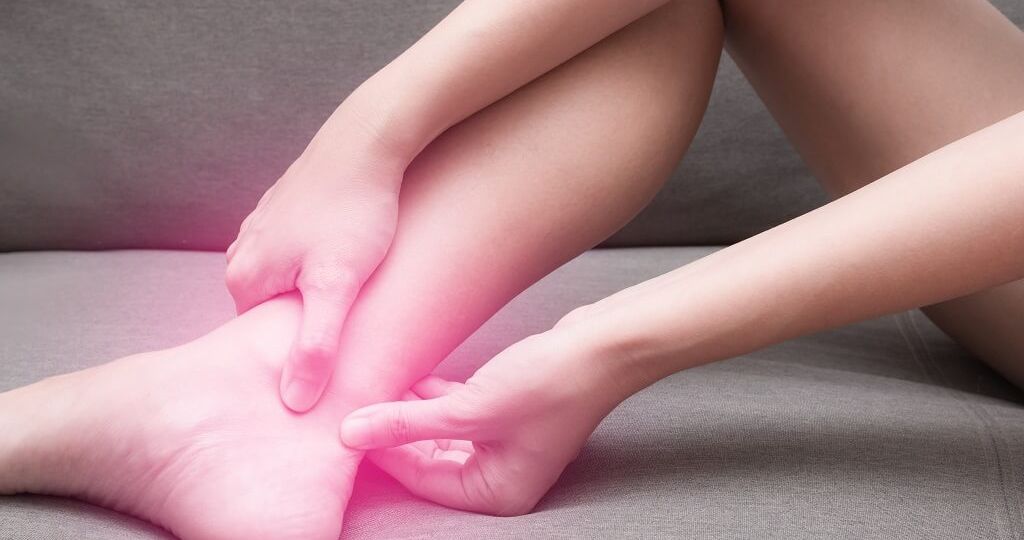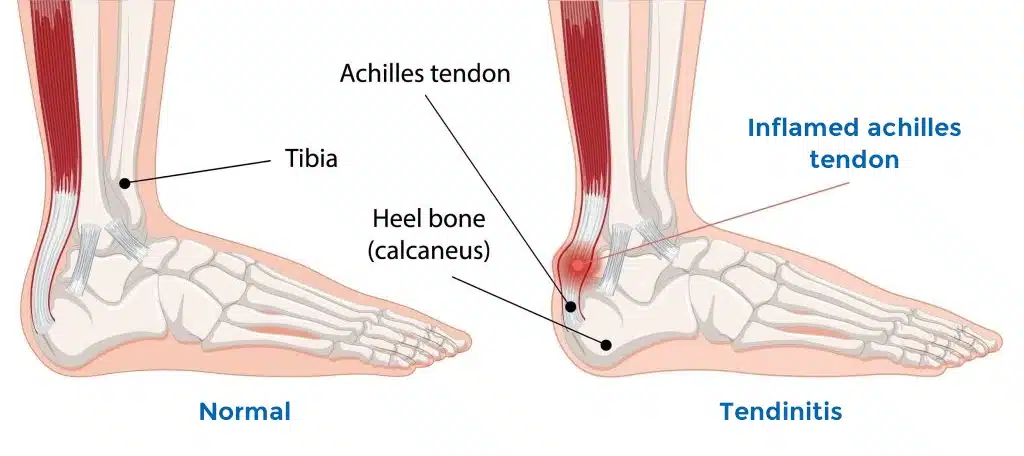
Our legs are the most important part of our body after the brain and heart. This is simply because they have the ability to bear the entire weight of the body and help us stand erect, walk or run. If our legs become impaired, the individual’s quality of life can become upended and decrease. Thus, it is imperative that we pay attention to even the slightest discomfort felt in the legs and attend to it immediately with specialized achilles tendonitis treatment from your local podiatrist.
Different bones and muscles along with tendons and tissues form the functional part of the legs like balancing, walking, running, stretching and jumping. Of these, the tendon joining the back of the heel bone and the calf muscle is the Achilles tendon and is responsible for walking and carrying out various athletic activities. This tendon is extremely important as it enables us to stand on our toes and move forward by pushing off of our feet. This visible, taut cord has the ability to stretch and release for forward movement. Any injury to Achilles tendon needs immediate attention.
Achilles Tendonitis
Achilles tendon pain can cause lot of discomfort and prove very painful while walking. Achilles tendonitis is inflammation or swelling of the Achilles tendon due to over exertion and strain.
The calf muscle and / or Achilles tendon have the tendency to become stiff and thus cause strain on the tendon. This strain translates to pain in the area behind the ankle, in the tendon and in the heel bone where the tendon attaches from the calf muscle.
The most basic Achilles tendon pain treatment in most cases is a simple stretching of calf muscles and the affected tendon. Since the cause of pain is tightening of the muscle, this stretch and relax routine helps to eliminate the stiffness and offers a certain degree of mobility to the muscle and the Achilles tendon.
Achilles tendonitis treatment in severe injury cases may prompt the foot and ankle specialist to put the ankle in a boot or cast to immobilize it, prescribe anti-inflammatory medicine, use a night splint to support and rest the muscle/tendon, advise physiotherapy or recommend the use of orthotic insoles for comfort.
Broken Achilles Tendon
Broken Achilles Tendon is an extreme case of injury to the Achilles Tendon and occurs when the tendon is broken in two parts or ruptured because of overactivity and strain. Athletes are more prone to this type of injury. Nonetheless, it can also occur in others due to stepping in the wrong direction, especially if you have a weakening of the muscles and tissues that support strenuous, rapid movements.
Under such circumstances, for the treatment of torn or partially damaged Achilles tendon, the specialist may put a cast and advice against putting weight on the area as in standing or walking. However, a total rupture may need surgery to rectify the tendon to help in restoring the functionality of the foot and assists in decreasing the severity of pain.
Prolonged Achilles Tendonitis
If the condition of Achilles tendonitis is unheeded and allowed to continue for a long time, it can cause further damage to the area, resuting in degeneration of the tendon. This condition is then termed “Achilles tendinopathy”. The location of the injury is in the same area of the tendon, behind the ankle where there is less blood supply to the tendon. As we age, the micro-tears in this area do not heal easily and cause further degeneration of the tendon. Such condition causes severe pain and swelling and is clearly visible as thickening of the Achilles tendon behind the ankle and back portion of the heel.
MRI report can ascertain the exact location, severity of the damage and the treatment is long-term immobilization. This may aid in restoring the condition to some extent. If the injury is too serious, then Stem cells therapy or Amniotic fluid injections help in accelerating the healing process and prevent its recurrence. Under extreme cases, surgery may be the last option to remove the damaged tissue and repair the broken tendon to relieve pain.
Achilles Heel Spur
An Achilles heel spur forms when a bony growth develops at the point where the Achilles tendon connects to the heel. This sharp, protruding spur can cause excruciating pain with every step, making even simple movements feel unbearable. Unlike typical heel pain, this condition is persistent and often worsens over time. For those suffering from severe discomfort, surgery offers a solution.
The procedure involves removing the spur and repairing the Achilles tendon, ensuring the tendon is properly reattached to restore function. To help prevent future pain, the surgeon may also lengthen the calf muscle and Achilles tendon, reducing strain and improving foot mechanics. If your heel pain has become a constant burden, treating an Achilles heel spur could be the first step toward finding lasting relief and getting back to pain-free movement.
Guide to Locate Heel and Ankle Specialists
A podiatrist will best address any issues related to the foot and ankle. Boca Raton has a number of highly qualified podiatrists to help give you the best treatment for your ankle and feet injuries and provide the proper achilles tendonitis treatment.
Certified Foot and Ankle Specialists in Boca Raton, Florida is the largest podiatry practice in the South Florida region with 19 doctors and 19 convenient locations. You can find them online in Broward or Palm Beach County or directly at certifiedfoot.com.
For your convenience, you can schedule a rapid appointment in any of the following cities where Certified Foot and Ankle Specialists has locations: Boca Raton, Ft. Lauderdale, Coral Springs, Boynton Beach, Palm City, Coconut Creek, West Palm Beach, Jupiter and Lake Worth.
For the Boca Raton podiatrist specifically, visit the clinic at 1601Clint Moore Road. The clinic is open from Monday to Friday from 8.30 am to 5 pm.
Email your questions to info@certifiedfoot.com or call (561) 258-9425 to secure an appointment with the doctors.
Conclusion
Foot and ankle injury can prove troublesome; as mentioned before, our legs balance the entire body weight, therefore it is necessary to pay heed to any injury that occurs to these body parts and attend to them at an earliest.
There are medical board certified foot and ankle specialists – podiatrists – that take care of this specific condition and help you recover from pain and injury, so you can get back on your feet.
Frequently Asked Questions
1. What are the most effective treatments for Achilles tendonitis pain?
The most effective treatments for Achilles tendonitis typically include a combination of rest, ice, and over-the-counter pain relievers like ibuprofen. Physical therapy may also help with strengthening and flexibility exercises. In some cases, more advanced treatments such as corticosteroid injections or shockwave therapy may be recommended. For severe cases, surgery might be necessary to repair the tendon.
2. How long does it take to recover from Achilles tendonitis?
Recovery time for Achilles tendonitis can vary depending on the severity of the condition. Mild cases may take a few weeks with rest and conservative treatments, while more severe cases could take several months to fully heal. Recovery time may also be influenced by the individual’s age, activity level, and how well they adhere to a rehabilitation plan.
3. Can Achilles tendonitis be treated at home, and if so, how?
Yes, Achilles tendonitis can often be managed at home with the right care. Resting the affected foot, applying ice to reduce swelling, and elevating the foot can help with initial pain relief. Over-the-counter anti-inflammatory medications may also be used. Gentle stretching and strengthening exercises, once the pain decreases, can help restore mobility and prevent future flare-ups.
4. When should I see a doctor for Achilles tendonitis pain?
If your Achilles tendonitis pain doesn’t improve with at-home care or if the pain is severe, persistent, or worsening, it’s time to see a doctor. Additionally, if you experience swelling, bruising, or a feeling of weakness in your Achilles tendon, it’s important to consult with a healthcare provider to rule out more serious injuries like a rupture.
5. Are there exercises or stretches that can help alleviate Achilles tendonitis?
Yes, specific exercises and stretches can help alleviate Achilles tendonitis. Calf stretches, such as the wall push-up or towel stretch, can improve flexibility. Strengthening exercises, like eccentric heel drops, can help strengthen the tendon. A physical therapist can provide a personalized exercise plan to ensure you’re doing the right activities to aid in your recovery and avoid further injury.



